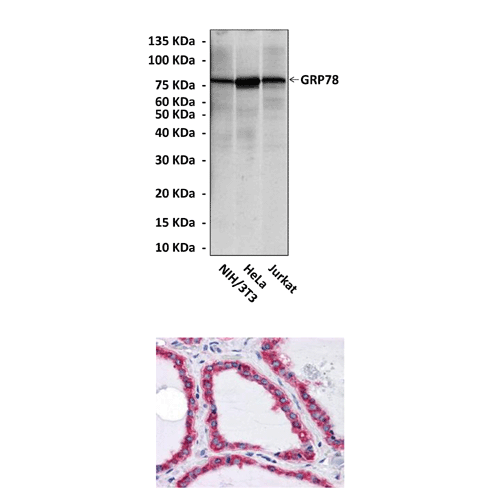Anti-GRP78/BiP/HSPA5: Mouse GRP78/BiP/HSPA5 Antibody |
 |
BACKGROUND The endoplasmic reticulum (ER) is an essential cellular organelle where secretory and membrane proteins are synthesized and modified and is also a major intracellular Ca2+ storage compartment. Recent discoveries further point to the ER as a novel focal point for the regulation of apoptosis. The unfolded protein response (UPR) triggers multiple pathways to allow cells to respond to ER stress. The endoplasmic reticulum (ER) is an essential intracellular organelle for the synthesis and maturation of cell surface and secretory proteins and maintenance of Ca2+ homeostasis. Disruption of these physiological functions leads to accumulation of unfolded proteins and induces the unfolded protein response (UPR). During this process, three ER transmembrane signaling molecules PERK, IRE1 and activating transcription factor-6 (ATF6) are activated. Activated PERK phosphorylates eukaryotic translation initiation factor-2α (eIF2α), which transiently blocks most protein translation and reduces the influx of nascent proteins into the ER lumen. Activated IRE1 releases its endonuclease activity, resulting in splicing of X-box-binding protein 1 (Xbp-1) mRNA, which encodes an active transcriptional factor. Another downstream target of IRE1 is c-Jun N-terminal kinase (JNK), the activation of which regulates cell death. Activated ATF6 translocates from the ER to the Golgi complex, where it is cleaved by S1P/S2P proteases and generates another active transcriptional factor. In concert or independently, ATF4, ATF6 and XBP-1 upregulate ER chaperone proteins, folding enzymes and protein degradation molecules, which in turn either prevent the aggregation of unfolded proteins, aid in their subsequent folding or in degradation of excessive misfolded proteins. A major UPR-upregulated target protein is the 78-kDa glucose-regulated protein, GRP78, an ER molecular chaperone also referred to as BiP and HSPA5. GRP78 is a member of the HSP70 protein family and is involved in many cellular processes, including translocating newly synthesized polypeptides across the ER membrane, facilitating the folding and assembly of newly synthesized proteins, maintaining them in a state competent for subsequent folding and oligomerization and regulating Ca2+ homeostasis.1 In addition to its chaperoning function, GRP78 is a key regulator of ER stress transducers. GRP78 binds and inhibits PERK, IRE1 and ATF6 activation in non-stressed cells. Upon ER stress and malfolded protein accumulation in the ER, these molecules are released from GRP78 and become activated. Recent studies reveal that GRP78 is antiapoptotic and plays critical cytoprotective roles in early embryogenesis, oncogenesis, neurodegenerative diseases and atherosclerosis. Furthermore, it was discovered that autophagy is activated upon ER stress as a defensive mechanism for survival. Evidence is emerging that the ER provides membrane for autophagosome formation and that autophagy is critical for ER homeostasis. Distinct classes of phosphatidylinositol-3′-kinases (PI3Ks) are involved in signaling pathways that control macroautophagy in mammalian cells.2
GRP78 induction occurs during embryonic development and has been widely reported in human cancer. GRP78 up-regulation is widely used as a sentinel marker for ER stress under pathologic conditions. In cancer cell lines, GRP78 promotes survival and chemoresistance in both proliferating and dormant tumor cells and has also been implicated in proliferation and invasion through activation of the Akt and PAK2 pathways. Given the importance of GRP78 in cancer cell survival, it is a prime target for discovery of anticancer agents. However, because GRP78 controls UPR signaling that has both prosurvival and proapoptotic pathways, down-regulation of GRP78 may result in premature activation of the UPR. It was demonstrated that a major protective arm of the UPR, GRP78/BiP, is critical for tumor proliferation, survival, and angiogenesis, underscoring its value as a novel therapeutic target for dual antitumor and antiangiogenesis activity.3
GRP78 induction occurs during embryonic development and has been widely reported in human cancer. GRP78 up-regulation is widely used as a sentinel marker for ER stress under pathologic conditions. In cancer cell lines, GRP78 promotes survival and chemoresistance in both proliferating and dormant tumor cells and has also been implicated in proliferation and invasion through activation of the Akt and PAK2 pathways. Given the importance of GRP78 in cancer cell survival, it is a prime target for discovery of anticancer agents. However, because GRP78 controls UPR signaling that has both prosurvival and proapoptotic pathways, down-regulation of GRP78 may result in premature activation of the UPR. It was demonstrated that a major protective arm of the UPR, GRP78/BiP, is critical for tumor proliferation, survival, and angiogenesis, underscoring its value as a novel therapeutic target for dual antitumor and antiangiogenesis activity.3
REFERENCES
1. Li, J. & Lee, A.S.: Curr. Mol. Med. 6:45-54, 2006
2. Fu, Y. et al: Proc. Natl. Acad. Sci. USA 105:19444-9, 2008
3. Dong, D. et al: Cancer Res. 68:498-505, 2008
2. Fu, Y. et al: Proc. Natl. Acad. Sci. USA 105:19444-9, 2008
3. Dong, D. et al: Cancer Res. 68:498-505, 2008
Products are for research use only. They are not intended for human, animal, or diagnostic applications.
Параметры
Cat.No.: | CP10356 |
Antigen: | Raised against recombinant human GRP78 fragments expressed in E. coli. |
Isotype: | Mouse IgG1 |
Species & predicted species cross- reactivity ( ): | Human, Mouse |
Applications & Suggested starting dilutions:* | WB 1:1000 IP n/d IHC 1:50 - 1:200 ICC n/d FACS n/d |
Predicted Molecular Weight of protein: | 78 kDa |
Specificity/Sensitivity: | Detects GRP78 proteins in various cell lysate. |
Storage: | Store at -20°C, 4°C for frequent use. Avoid repeated freeze-thaw cycles. |
*Optimal working dilutions must be determined by end user.
Документы
Информация представлена исключительно в ознакомительных целях и ни при каких условиях не является публичной офертой








